2.4 Infrastructure
2.4.1 Fences
| |
| Location of Example: |
25°17'49" South, 152°38'43" East |
| Distinctive Characteristics: |
- Fences tend to be depicted as narrower features than roads. They generally form polygonal shapes, outlining paddocks and properties. They also tend to cut across properties unlike roads.
- The fences stand out as a narrower band of lighter blue as opposed to the thicker darker signature of the roads.
- Fences generally enclose property boundaries or internal paddocks but do not provide connectivity or access to the farm infrastructure, i.e. Homesteads, Buildings, Water Tanks, etc.
|
| Regional Considerations: |
|
| Figure: 2.4.1.1 Representation of Fences Vs Roads. |
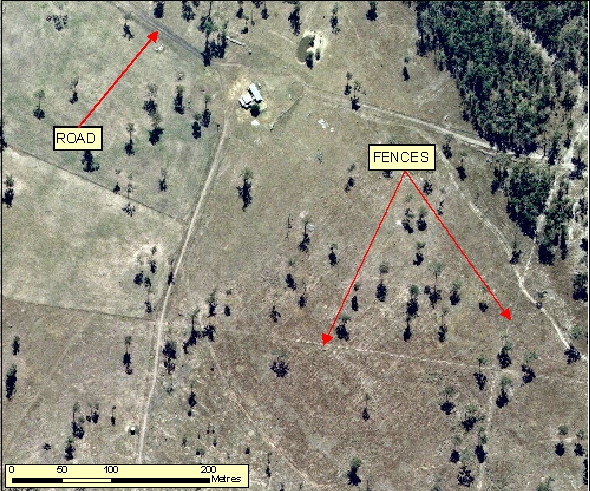
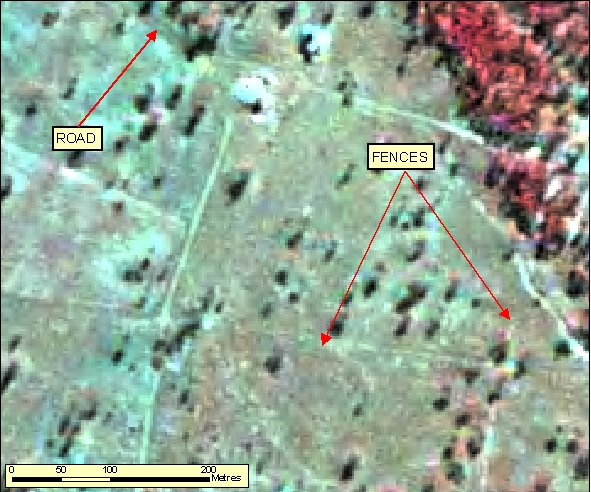
[back to top]
2.4.2 Water Towers
2.4.2.1 Example 1
| |
| Location of Example: |
152°20'25" East, 24°51'04" South |
| Distinctive Characteristics: |
- Water Towers appear as circular elevated features. This is evident by the shadow signature.
- Water Towers tend to be solitary, unlike Storage Tanks that are typically concentrated in one area.
|
| Regional Considerations: |
- Water Towers are typically found in regional centres, residential/urban areas, unlike Storage Tanks which are typically found in industrial/commercial areas.
|
| Figure: 2.4.2.1 Representation of a Water Tower in association with surrounding features. |
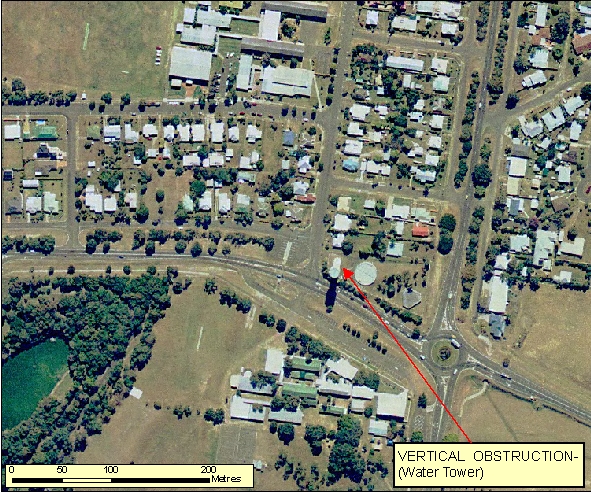
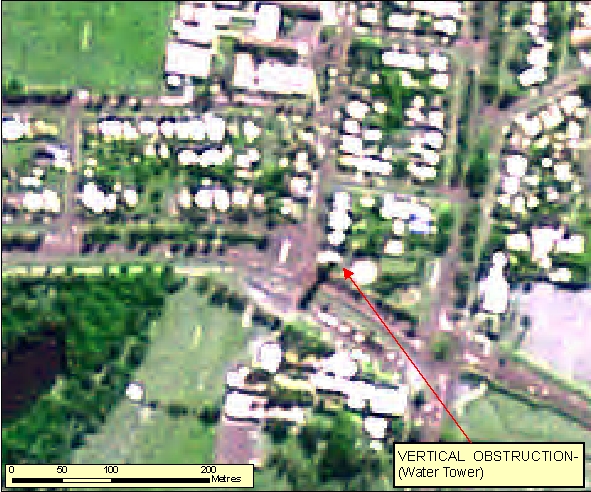
[back to top]
2.4.2.2 Example 2
| |
| Location of Example: |
| Distinctive Characteristics: |
- Water Towers are of various constructions as per Figure: 2.4.2.2.
- Water Towers are typically located within or nearby Population Centres, they are significant topographic features because of their height.
|
| Regional Considerations: |
|
| Figure: 2.4.2.1 Photographs of Water Towers. |
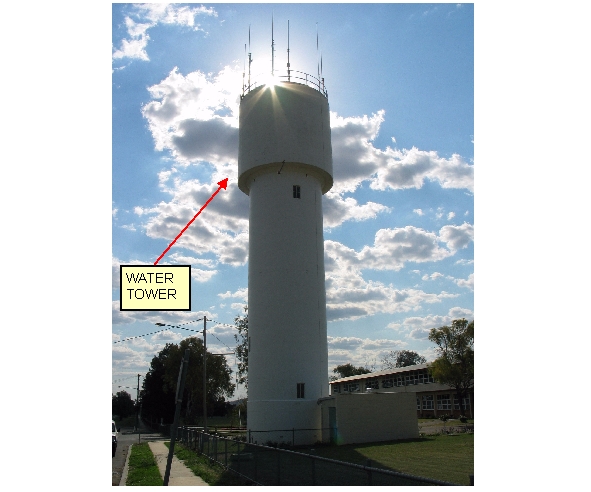
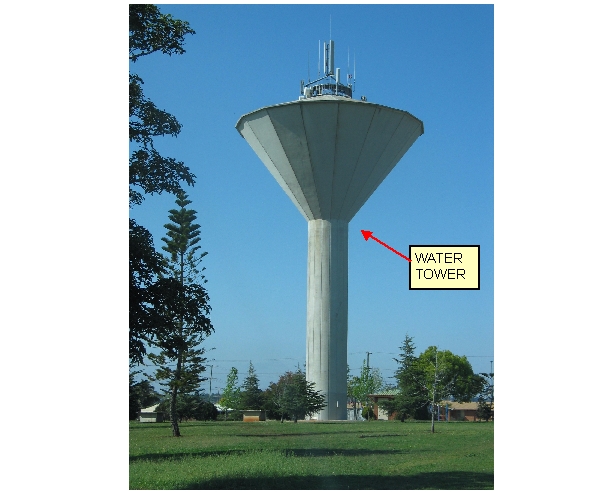
[back to top]
2.4.2.3 Example 3
| |
| Location of Example: |
Not Recorded |
| Distinctive Characteristics: |
- Elevated Water Tanks appear as circular elevated features.
- Elevated Water Tanks can vary in height and a shadow signature can be difficult to detect dependant on imagery and elevation height.
- Elevated Water Tanks may be adjacent to other larger grounded water tanks on farm land or on higher ground to take into account the additional advantage of increased gravity
|
| Regional Considerations: |
- Elevated Water Tanks appear on farms as a method of regulating water flow accross a property or near small regional centres.
|
| Figure: 2.4.2.3 Representation of Elevated Water Tank on farm. |
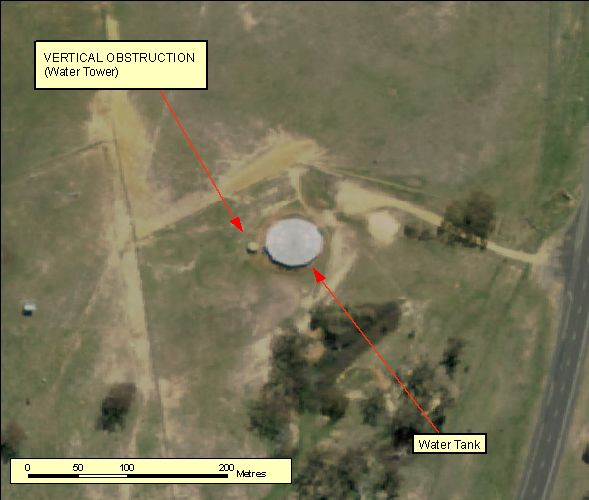
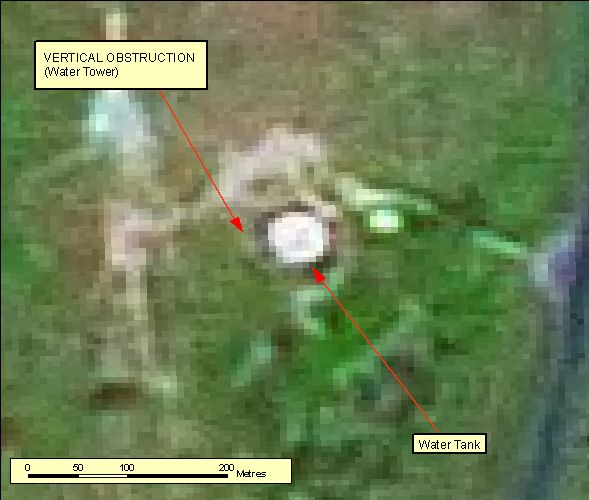
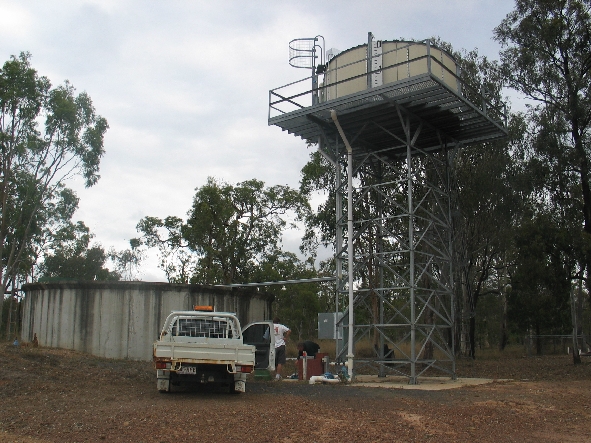
[back to top]
2.4.3 Storage Tanks
2.4.3.1 Example 1
| |
| Location of Example: |
152°50'43" East, 25°17'16" South |
| Distinctive Characteristics: |
- Storage Tanks appear as circular elevated features, this is evident by the shadow signature.
- Storage Tanks may or may not have an enclosed roof.
- Storage Tanks can sometimes be distinguished from Water Tanks/Water Towers because they are typically found in industrial/commercial areas rather than within residential/urban areas.
- Numerous Storage Tanks are typically concentrated in one area, whereas Water Tanks/Water Towers tend to be more solitary.
|
| Regional Considerations: |
|
| Figure: 2.4.3.1 Representation of Storage Tanks in association with surrounding features. |
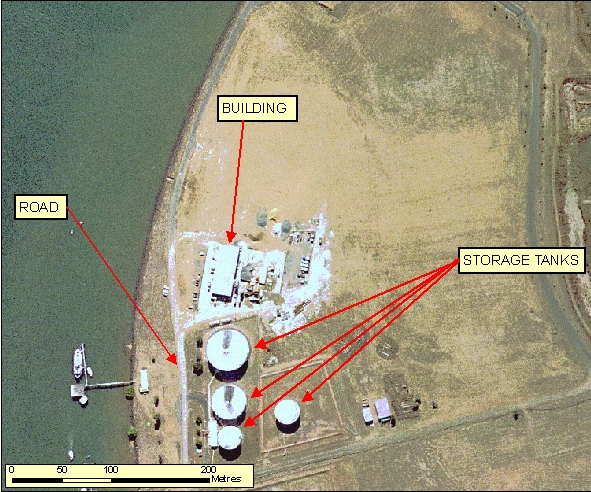
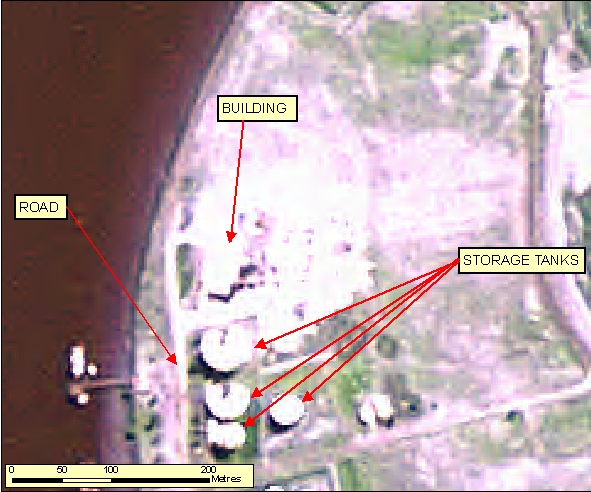
[back to top]
2.4.3.2 Example 2
| |
| Location of Example: |
152°23'05" East, 24°46'03" South |
| Distinctive Characteristics: |
- Storage Tanks appear as circular elevated features, this is evident by the shadow signature.
- Storage Tanks may or may not have an enclosed roof.
- Storage Tanks can sometimes be distinguished from Water Tanks/Water Towers because they are typically found in industrial/commercial areas rather than within residential/urban areas.
- Numerous Storage Tanks are typically concentrated in one area, whereas Water Tanks/Water Towers tend to be more solitary.
|
| Regional Considerations: |
|
| Figure: 2.4.3.2 Representation of a Storage Tanks in association with surrounding features. |
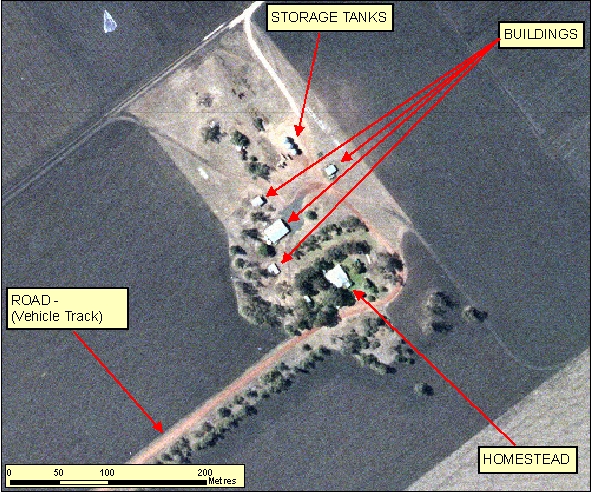
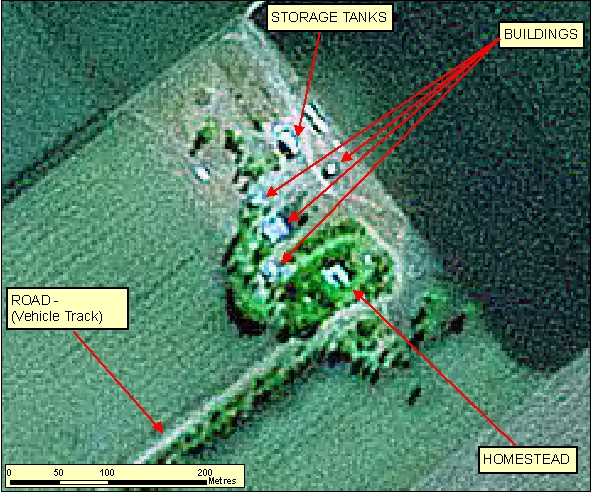
[back to top]
2.4.3.3 Example 3
| |
| Location of Example: |
151°15'27" East, 23°50'6" South |
| Distinctive Characteristics: |
- Storage Tanks appear as circular elevated features, this is evident by the shadow signature.
- Storage Tanks may or may not have an enclosed roof.
- Storage Tanks can sometimes be distinguished from Water Tanks/Water Towers because they are typically found in industrial/commercial areas rather than within residential/urban areas.
- Numerous Storage Tanks are typically concentrated in one area, whereas Water Tanks/Water Towers tend to be more solitary.
- Storage Tanks may be distinguished from Silos by their flat roof structure compared with a conical roof structure of a Silo.
- The roof of a Storage Tank may show temporal change due to the amount of product stored in the Tank when the imagery was captured.
|
| Regional Considerations: |
|
| Figure: 2.4.3.4 Representation of Storage Tanks in association with surrounding features. |
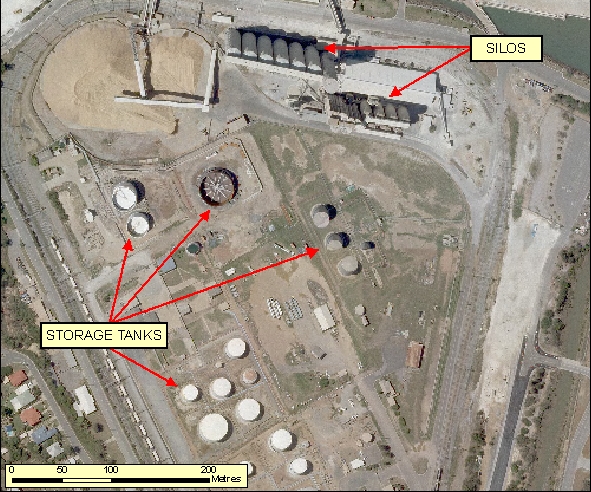
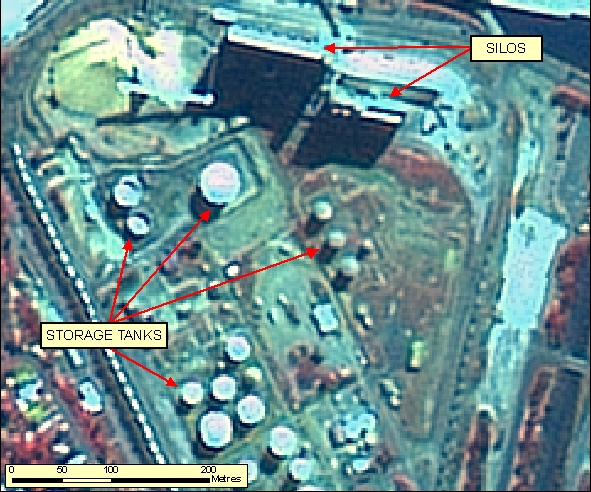
[back to top]
2.4.4 Mine Areas
2.4.4.1 Example 1
| |
| Location of Example: |
152°28'10" East, 24°51'33" South |
| Distinctive Characteristics: |
- Sand/gravel quarries consist of a series of small to medium sized pits.
- Infrastructure associated with quarries varies according to size and ownership. Small quarries used for intermittent road repairs and owned by local government authorities are not likely to have much associated infrastructure. Large commercial operations close to large cities are more likely to have extensive crushing, stockpiling and administrative facilities.
|
| Regional Considerations: |
|
| Figure: 2.4.4.1 Representation of a Mine Area in association with surrounding features. |
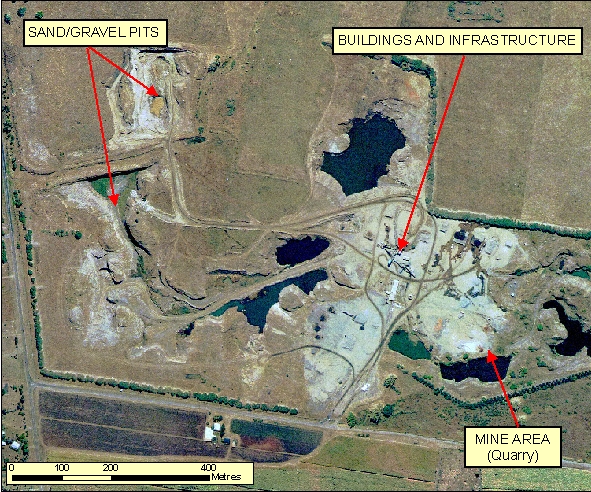
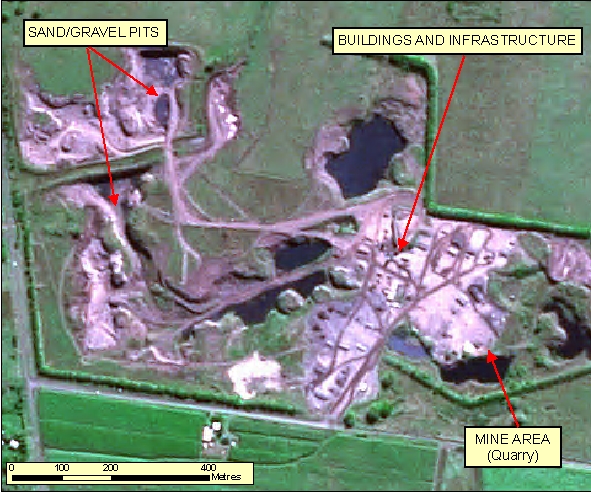
[back to top]
2.4.4.2 Example 2
| |
| Location of Example: |
151°59'9" East, 27°56'9" South |
| Distinctive Characteristics: |
- Hard rock quarries are typically sited in foothills flanking urban and peri-urban centres.
- Hard rock quarries are generally composed of one main medium-sized pit and excavated into a hillside.
- The excavation depth is evident by terracing and it's associated shadow signatures.
- In Figure: 2.4.3.2b the spectral signature of the bedrock is dark blue/grey. This should be similar to the spectral signature of rocky slopes and outcrops devoid of vegetation.
|
| Regional Considerations: |
|
| Figure: 2.4.4.2 Representation of a Mine Area in association with surrounding features. |
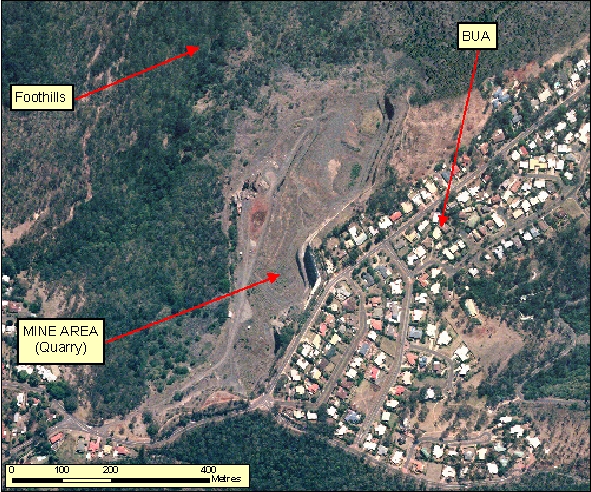
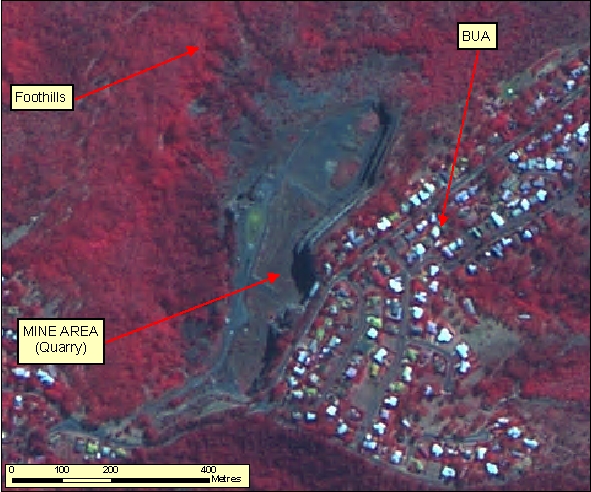
[back to top]
2.4.4.3 Example 3
| |
| Location of Example: |
151°15'29" East, 27°56'42" South |
| Distinctive Characteristics: |
- Open cut mines are usually metalliferous or coal mines.
- Open cut mines are generally quite large compared with quarries and underground mines.
- Large open cut mine features are usually located away from settled areas and are often associated with extensive surface infrastructure, such as processing facilities, stockpiles, haul roads, settling ponds, power lines, mine accommodation villages, transport facilities.
- In Figure: 2.4.4.3b the spectral signature of the land disturbance is light blue/grey compared with the surrounding land and vegetation that is red/brown.
|
| Regional Considerations: |
|
| Figure: 2.4.4.3 Representation of a Mine Area in association with surrounding features. |
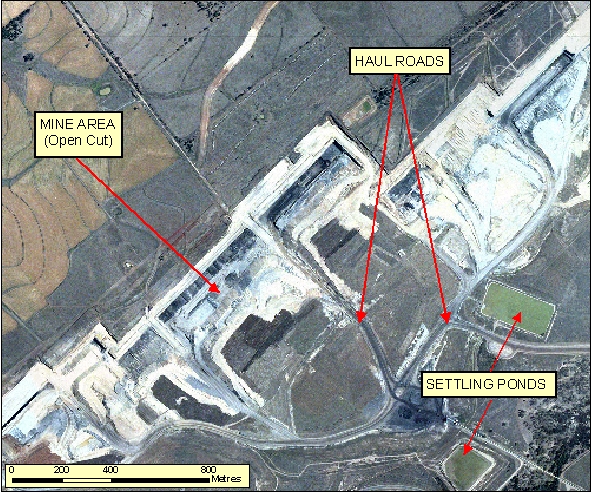
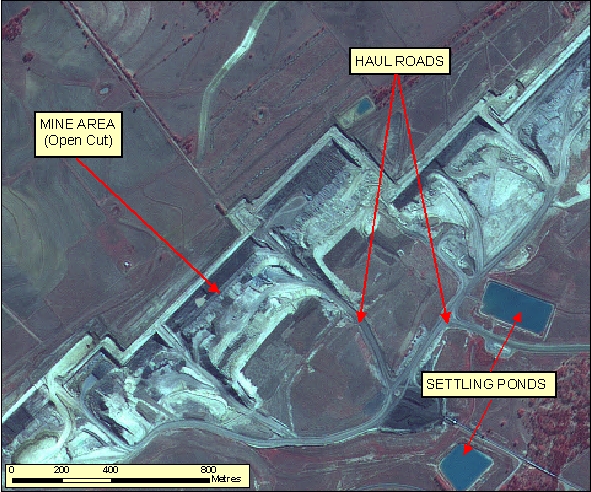
[back to top]
2.4.4.4 Example 4
| |
| Location of Example: |
151°15'29" East, 27°56'42" South |
| Distinctive Characteristics: |
- Sand/gravel quarries consist of a series of small to medium sized pits.
- Infrastructure associated with quarries varies according to size and ownership. Small quarries used for intermittent road repairs and owned by local government authorities are not likely to have much associated infrastructure. Large commercial operations close to large cities are more likely to have extensive crushing, processing, stockpiling and administrative facilities.
- Interpretation of components within complex Mine Areas is difficult from imagery alone. Use additional Reference Material where available or seek further clarification from Geoscience Australia via Action Request.
- As illustrated in Figure 2.4.4.4 there may be a temporary presence of water in a Mine Area. The mine acts as it´s own catchment. These temporary catchments should not be captured as a water body area.
|
| Regional Considerations: |
|
| Figure: 2.4.4.4 Representation of a Mine Area in association with surrounding features. |
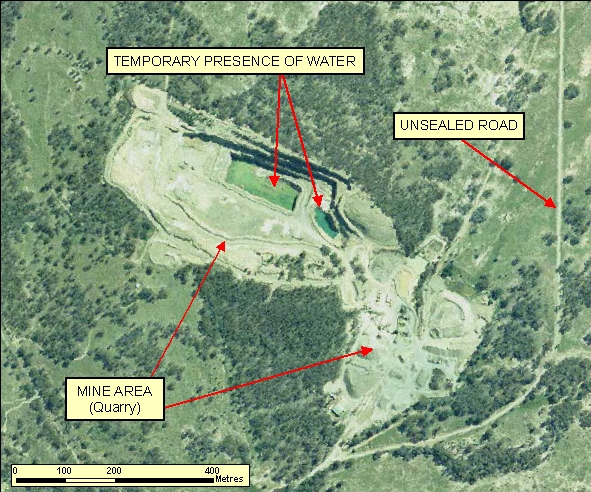
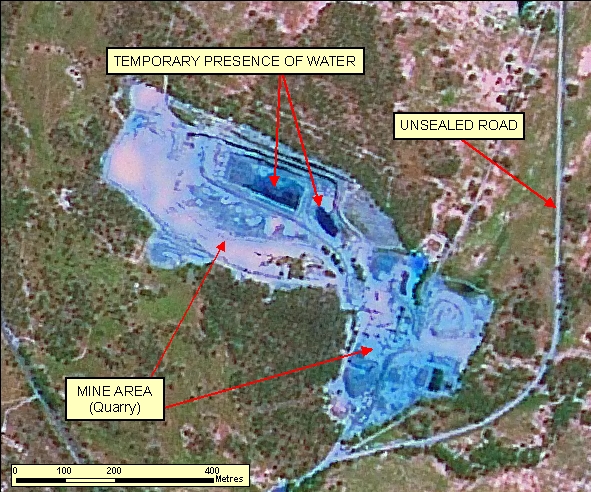
[back to top]
2.4.4.5 Example 5
| |
| Location of Example: |
150°53'48" East, 32°11'34" South |
| Distinctive Characteristics: |
- Figure 2.4.4.5 is an example of a complex Mine Area.
- Interpretation of components within complex Mine Areas is difficult from imagery alone. Use additional Reference Material where available or seek further clarification from Geoscience Australia via Action Request.
|
| Regional Considerations: |
|
| Figure: 2.4.4.5 Representation of a complex Mine Area. |
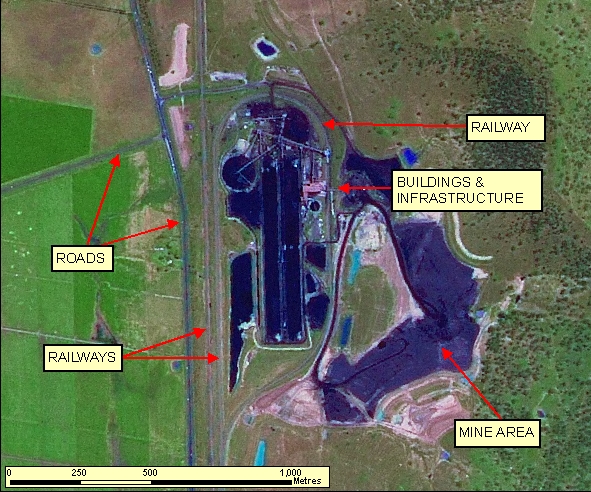
[back to top]
2.4.4.6 Example 6
| |
| Location of Example: |
149°50'52" East, 34°44'28" South |
| Distinctive Characteristics: |
- Infrastructure associated with quarries varies according to size and ownership. Small quarries used for intermittent road repairs and owned by local government authorities are not likely to have much associated infrastructure. Large commercial operations close to large cities are more likely to have extensive crushing, processing, stockpiling and administrative facilities.
- As illustrated in Figure 2.4.4.6 there may be a temporary presence of water in a Mine Area. The mine acts as it's own catchment. These temporary catchments should not be captured as a water body area.
|
| Regional Considerations: |
|
| Figure: 2.4.4.6 Representation of a Mine Area in association with surrounding features. |
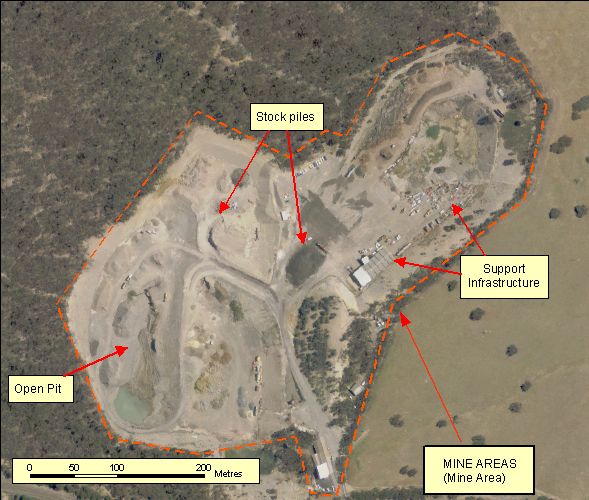
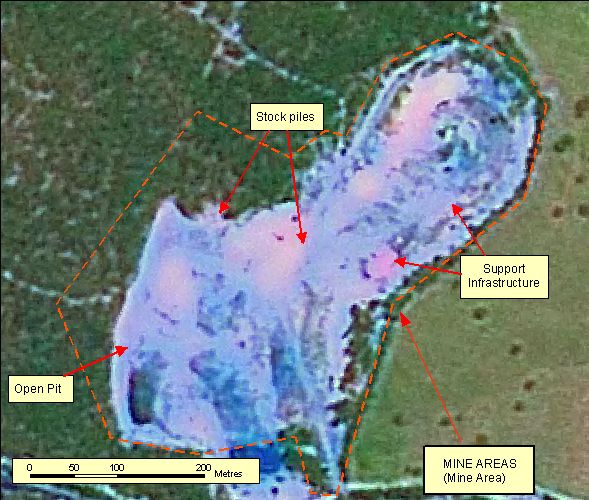
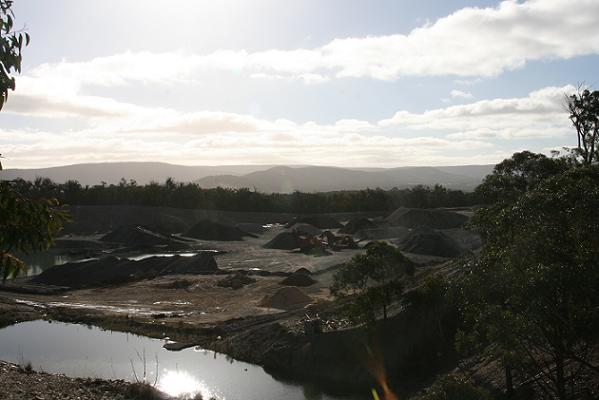
[back to top]
2.4.5 Yards
2.4.5.1 Example 1
| |
| Location of Example: |
150°21'26" East, 34°35'13" South |
| Distinctive Characteristics: |
- These are enclosed areas, usually on or near pastoral land, for the purposes of confining livestock for a specific purpose.
- Small yards located on farming land often include a roofed area to provide livestock with shelter from the weather.
- Larger yards, usually for the purposes of holding many animals, can be partitioned off into different areas to segregate the animals.
- Large Yards may exist on the edges of regional population centres for Livestock sales to markets or other farming communities
|
| Regional Considerations: |
|
| Figure: 2.4.5.1 Representation of a small yard on pastoral lands. |
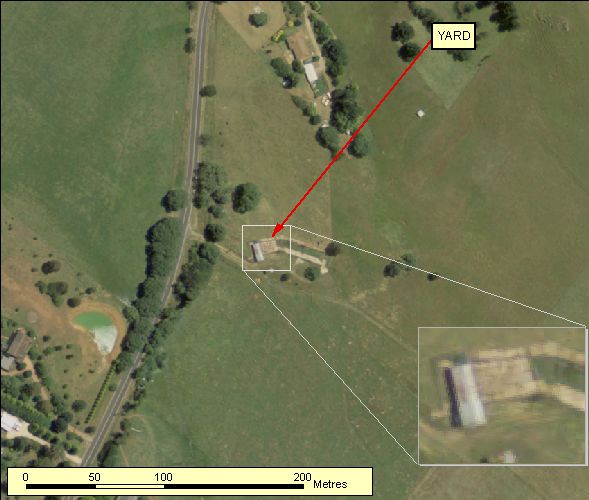
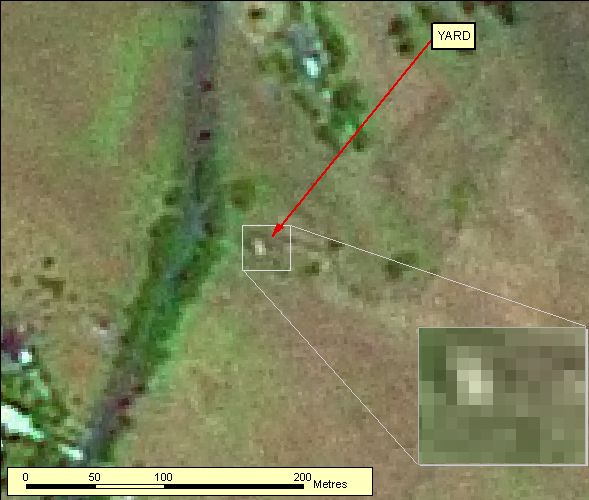
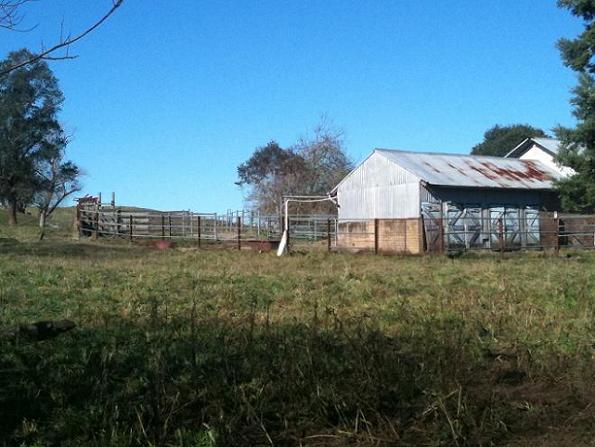
[back to top]
2.4.5.2 Example 2
| |
| Location of Example: |
148°55'37" East, 34°51'17" South |
| Distinctive Characteristics: |
- These are enclosed areas, usually on or near pastoral land, for the purposes of confining livestock for a specific purpose.
- Small yards located on farming land often include a roofed area to provide livestock with shelter from the weather.
- Larger yards, usually for the purposes of holding many animals, can be partitioned off into different areas to segregate the animals.
- Large Yards may exist on the edges of regional population centres for Livestock sales to markets or other farming communities
- Regional sale yards are often accompanied by areas for truck parking and manoeuvring.
|
| Regional Considerations: |
|
| Figure: 2.4.5.2 Representation of a Regional Sales Yard. |
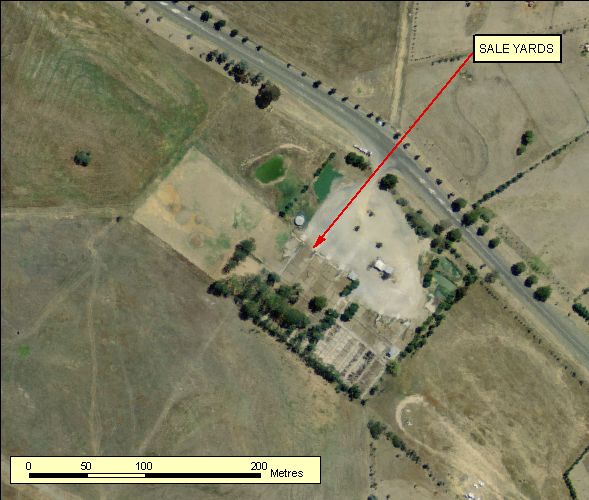
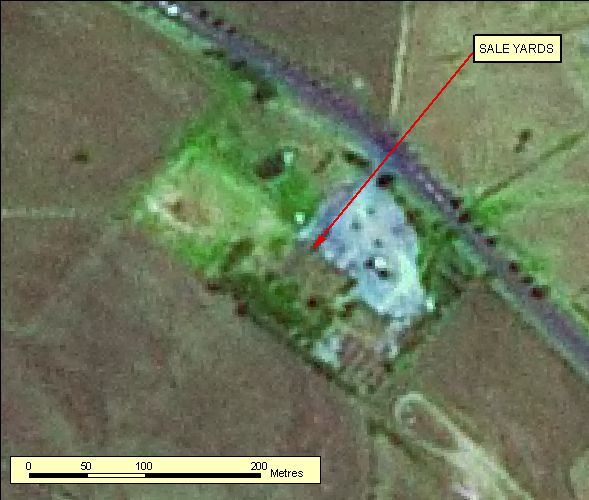
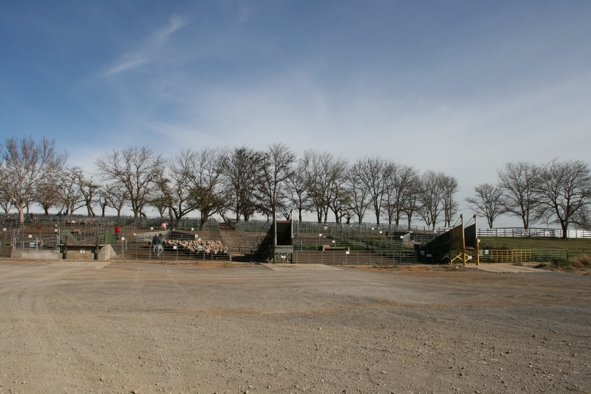
[back to top]
2.4.6 Chimneys
2.4.6.1 Example 1
| |
| Location of Example: |
116°15'38" East, 33°20'35" South |
| Distinctive Characteristics: |
- Chimneys appear as solid circular features which extend vertically. This is evident by the shadow signature.
- Chimneys are generally associated with hard mass production industries or power generation facilities. Delivering steam or pollutants (such as smoke) away from a building structure
|
| Regional Considerations: |
|
| Figure: 2.4.6.1 Representation of a Chimney and surrounding features. |
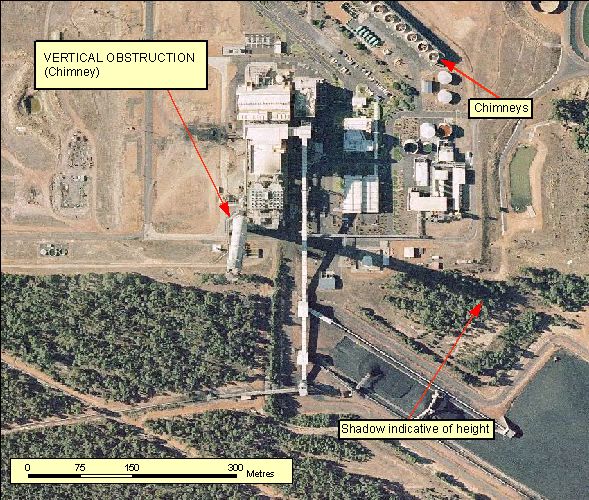
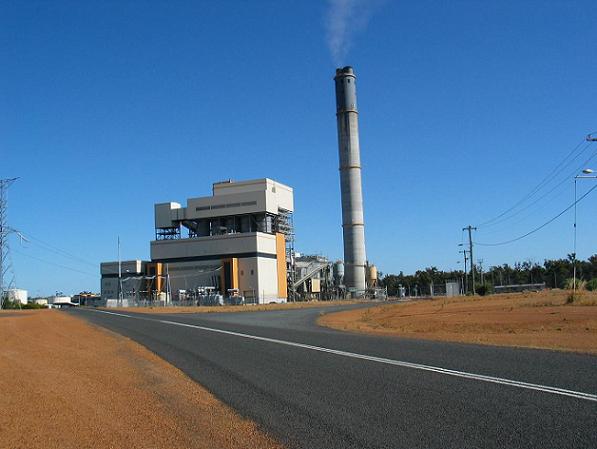
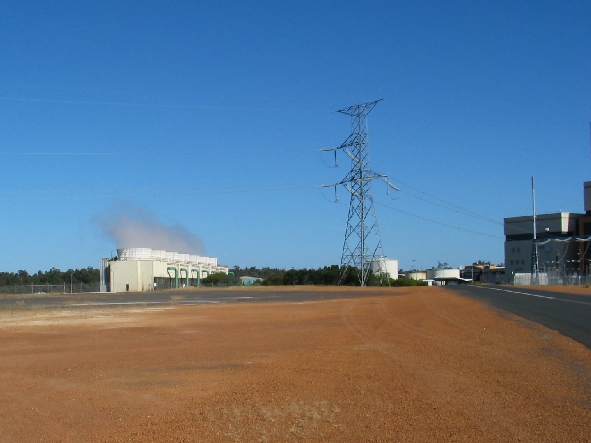
[back to top]
2.4.7 Fire Towers
2.4.7.1 Example 1
| |
| Location of Example: |
149°59'44" East, 35°28'47" South |
| Distinctive Characteristics: |
- Fire Towers are generally framework square or rectangular tower structures, with a room structure situated at the top.
- A Fire tower is a watchtower where a lookout is posted to watch for fires.The fire tower provides housing and protection for the lookout.
- A fire tower is usualy located at the summit of a mountain, or other high vantage points in order to maximize the viewing distance and range.
- Generally an established and well maintained vehicular track will curve up to summit fire towers for ease of access and quick escape.
- Land in close proximity is cleared of vegetation both for increased visibility as well as a fire protection mechanism.
|
| Regional Considerations: |
- Exists in large wooded forest regions prone to bushfire.
|
| Figure: 2.4.7.1 Representation of a Fire Tower and surrounding features. |
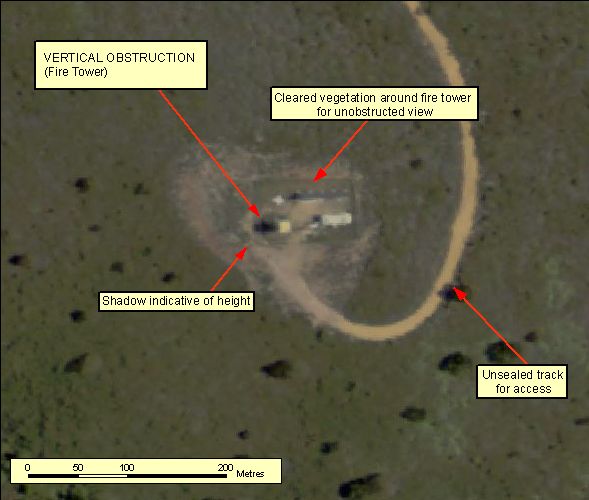
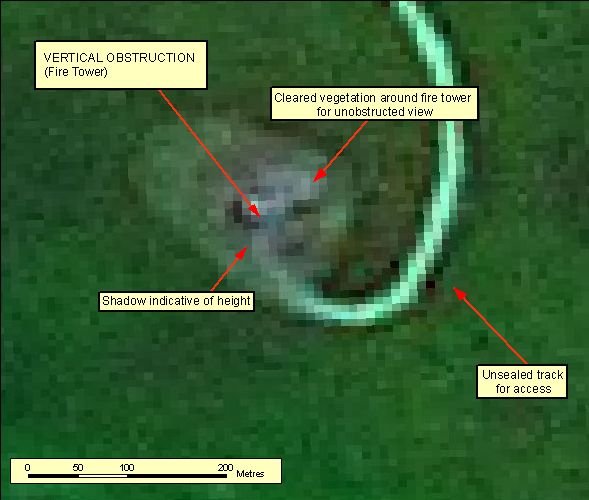
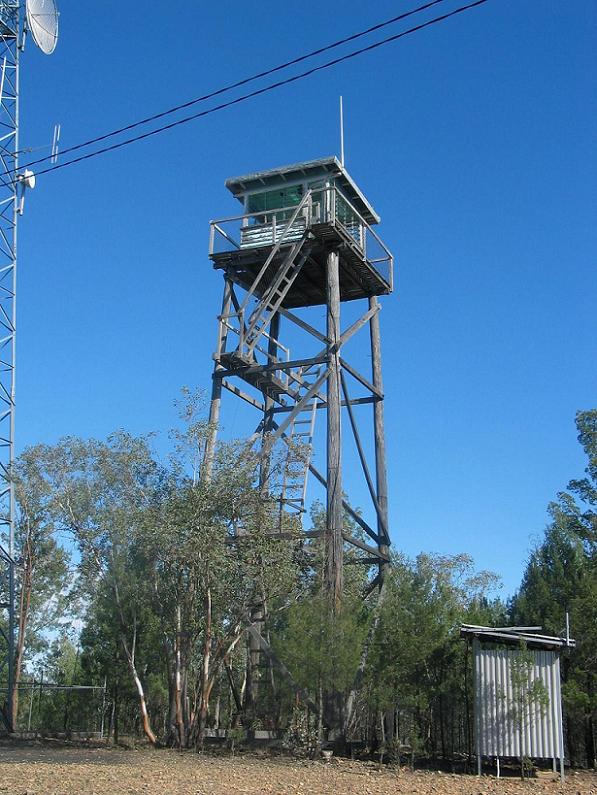
[back to top]
2.4.8 Silos
2.4.8.1 Example 1
| |
| Location of Example: |
148°57'52" East, 34°52'35" South |
| Distinctive Characteristics: |
- The example denotes how to distinguish silos from water tanks in small farm situations.
- Silos are often found in groups or rows. Water tanks are often found in isolation. Water tanks may also utilise building roofs to capture rain water and therefore could be situated directly adjacent to buildings.
- Water Tanks in small farmsteads will generally be situated close to the main resident or farm buildings. Silos are more likely to be situated further from the main buildings due to their possible flammability and may be closer to where farm equipment will be stored.
- Note: Figure 2.4.8.1c shows an oblique photograph of non permanent silos. These have become more frequent in Australia's landscape. They are normally situated on concrete slabs but can if required be picked up and moved to another part of the farm. Distinguishing between permanent and non permanent silos will be dependant on resolution and angle of imagery.
|
| Regional Considerations: |
- Exists in crop farming regions.
|
| Figure: 2.4.8.1 Representation of a Silo and Water Tanks in a small farm situation. |
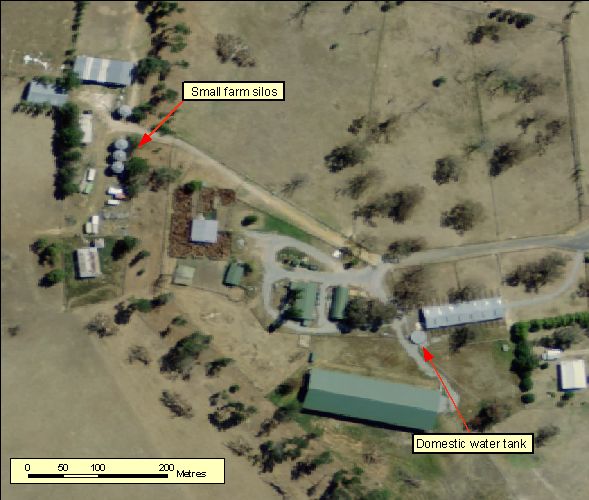
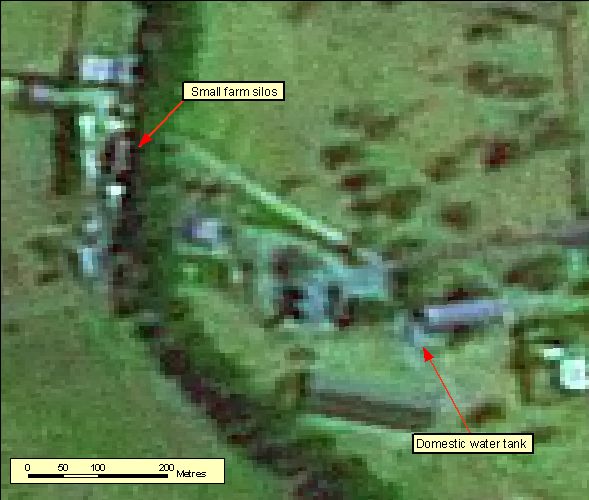
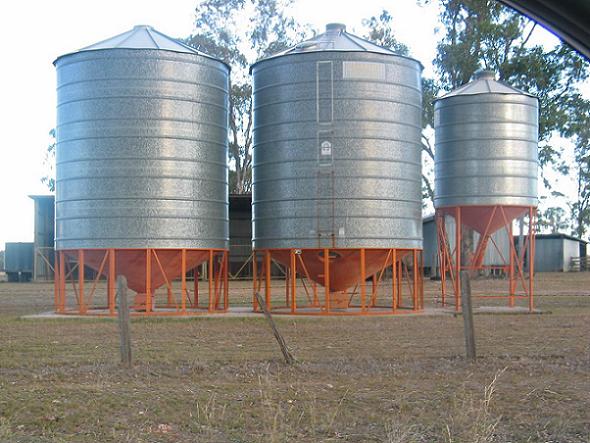
[back to top]
2.4.8.2 Example 2
| |
| Location of Example: |
Not Recorded |
| Distinctive Characteristics: |
- Large grain storage can occur in interconnected Silos.
- These can occur close to transportation links such as railways or shipping, near the edges of regional centres or near large food processing plants
|
| Regional Considerations: |
|
| Figure: 2.4.8.2 Representation of a Large Interconnected Silos. |
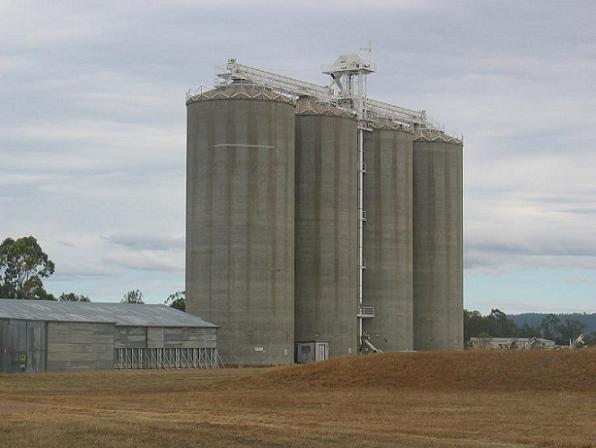
[back to top]
2.4.8.3 Example 3
| |
| Location of Example: |
151°14'45" East, 27°10'52" South |
| Distinctive Characteristics: |
- Large grain storage can occur in interconnected Silos.
- These can occur close to transportation links such as railways or shipping, near the edges of regional centres or near large food processing plants
|
| Regional Considerations: |
|
| Figure: 2.4.8.3 Representation of Silos in association with surrounding features. |
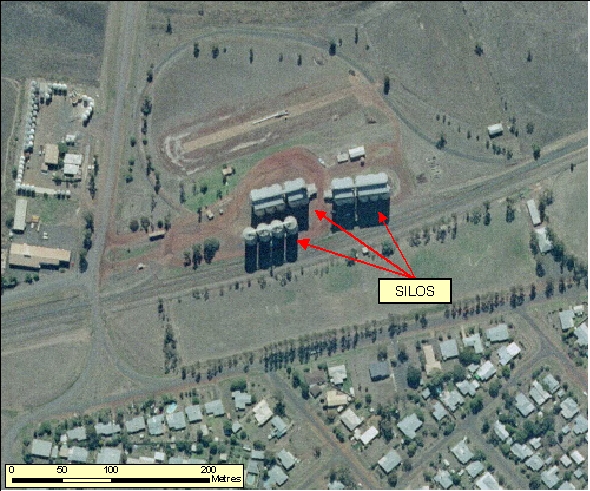

[back to top]
2.4.9 Wind Turbine Generator
2.4.9.1 Example 1
| |
| Location of Example: |
149°12'27" East, 33°37'17" South |
| Distinctive Characteristics: |
- Wind Power Generation Facilities or Wind Farms produce electricity from the use of one or multiple wind turbine generators.
- The distinctive wind turbine generators are generally tall solid column structures with rotating blades which produces energy from the wind.
- Wind turbines will be separated by a horizontal distance (varying from 100m to more than 2km) to allow for uninteruppted wind flow. Maintenance tracks appear between generators.
- Land used for wind turbines will generally be dual purpose allowing for sheep, cattle or crop production.
- Shadows of the turbines can sometimes be a clearer identifier of the turbines than the turbines themselves dependant on the angle of the imagery being viewed.
|
| Regional Considerations: |
- Wind Power Generation Facilities are usually found where strong winds are prevalent.
- Coastal land, ridges and large open agricultural or pastoral land are the most likely locations for wind farms.
- They normally are not near large populated centres due to noise concerns.
|
| Figure: 2.4.9.1 Representation of a Wind Farm Power Generation Facility. |
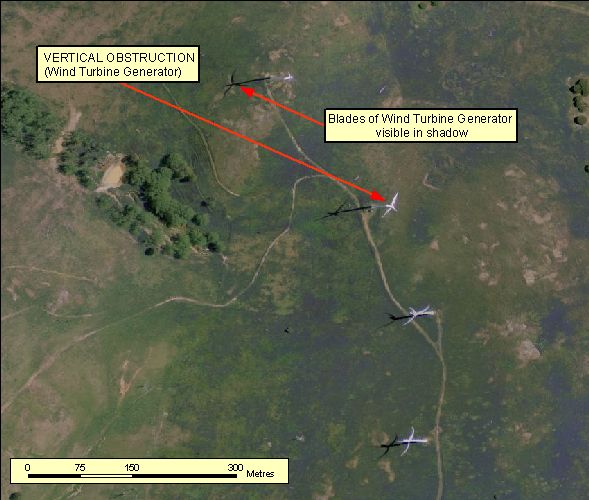
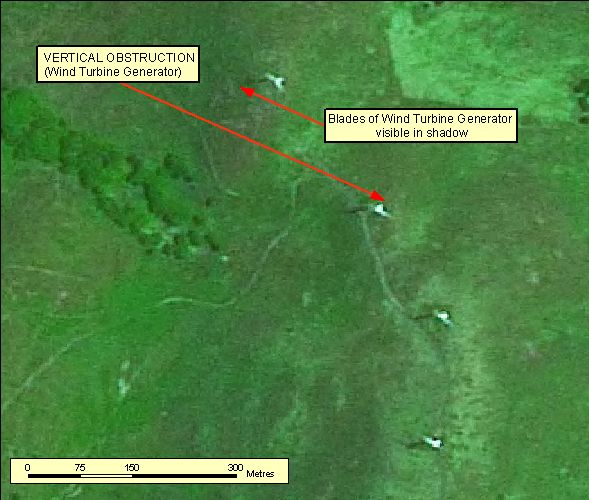
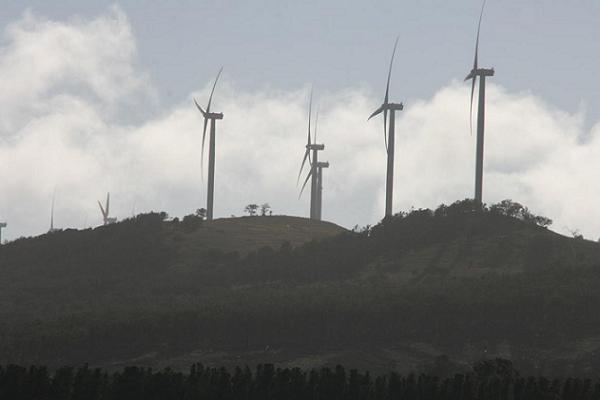
2.4.10 Grain Bunker
2.4.10.1 Example 1
| |
| Location of Example: |
136°25'44" East, 33°07'09" South |
| Distinctive Characteristics: |
- Grain Bunkers are often found in groups or rows. Most have raised brick/concrete walls to retain the grain.
- When filled with grain, the bunker is covered - often by a fabric material
|
| Regional Considerations: |
- Exists in crop farming regions.
|
| Figure: 2.4.10.1 Representation of a Grain Bunker. |
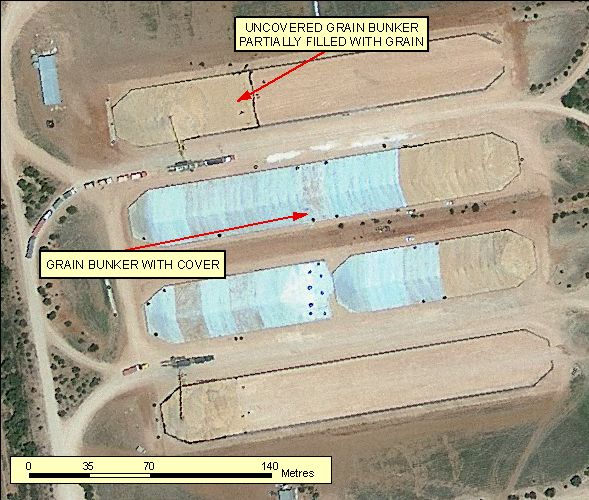
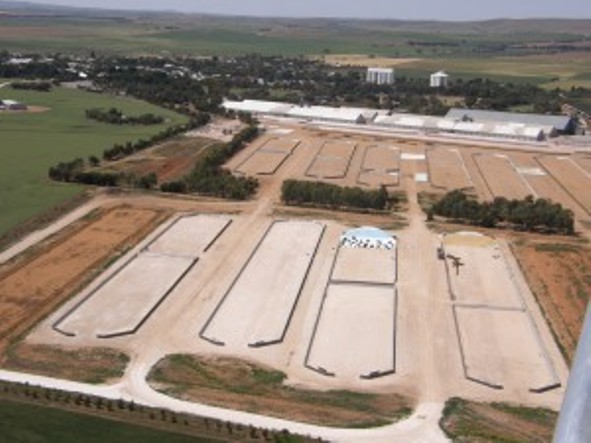
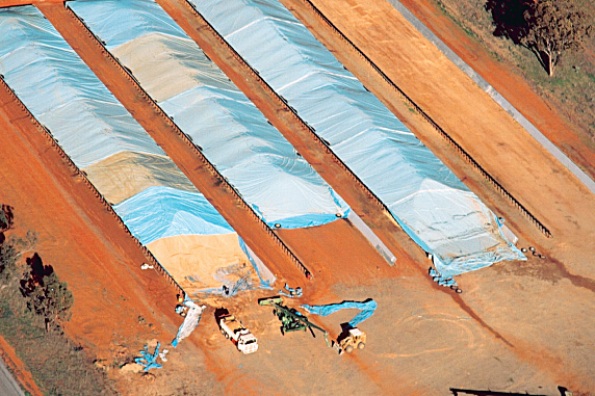
Topic contact: mapfeedback@ga.gov.au Last updated: January 20, 2012



















































